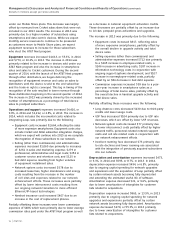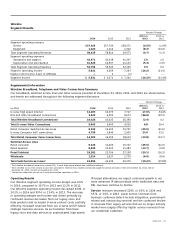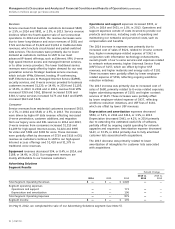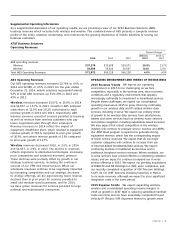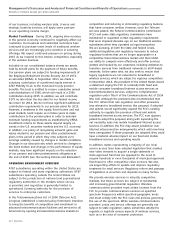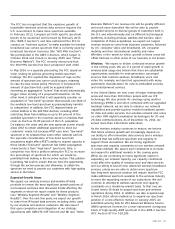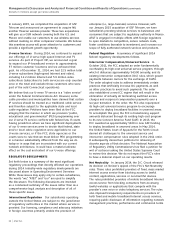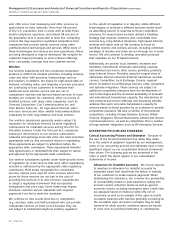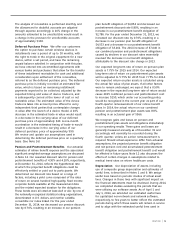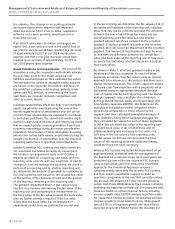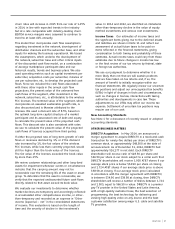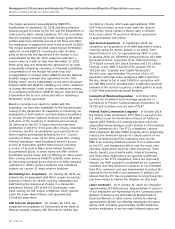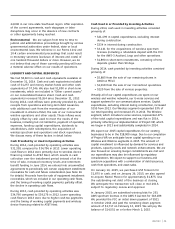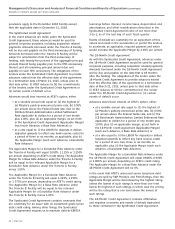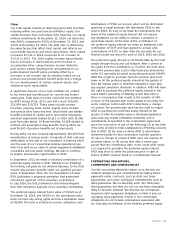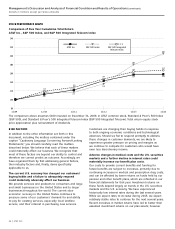AT&T Wireless 2014 Annual Report Download - page 28
Download and view the complete annual report
Please find page 28 of the 2014 AT&T Wireless annual report below. You can navigate through the pages in the report by either clicking on the pages listed below, or by using the keyword search tool below to find specific information within the annual report.
Management’s Discussion and Analysis of Financial Condition and Results of Operations (continued)
Dollars in millions except per share amounts
26
|
AT&T INC.
In the second step, we determine the fair values of all of
the assets and liabilities of the reporting unit, including
those that may not be currently recorded. The difference
between the sum of all of those fair values and the
overall reporting unit’s fair value is a new implied
goodwill amount, which we compare to the recorded
goodwill. If implied goodwill is less than the recorded
goodwill, then we record an impairment of the recorded
goodwill. The amount of this impairment may be more
or less than the difference between the overall fair
value and book value of the reporting unit. It may even
be zero if the fair values of other assets are less than
their book values.
As shown in Note 7, all of our goodwill resides in the
Wireless and Wireline segments. For each of those
segments, we assess their fair values using an income
approach (also known as a discounted cash flow) and a
market multiple approach. The income approach utilizes
a 10-year cash flow projection with a perpetuity value
discounted using an appropriate Weighted Average
Cost of Capital rate for each reporting unit. The market
multiple approach uses a multiple of a company’s
Earnings Before Interest, Taxes, and Depreciation and
Amortization expenses (EBITDA). We determined the
multiples of the publicly traded companies whose
services are comparable to those offered by the
segment and then calculated a weighted-average of
those multiples. Using those weighted averages, we
then calculated fair values for each of those segments.
In 2014, the calculated fair value of the reporting unit
exceeded book value in all circumstances and no
additional testing was necessary. In the event of a
10% drop in the fair values of the reporting units,
the fair values would have still exceeded the book
values of the reporting units and additional testing
would still have not been necessary.
Wireless FCC licenses are tested for impairment on an
aggregate basis, consistent with the management of
the business on a national scope. As in prior years, we
performed our test of the fair values of FCC licenses
using a discounted cash flow model (the Greenfield
Approach). The Greenfield Approach assumes a
company initially owns only the wireless FCC licenses,
and then makes investments required to build an
operation comparable to the one that currently utilizes
the licenses. We utilized a 17-year discrete period to
isolate cash flows attributable to the licenses, including
modeling the hypothetical build-out. The projected cash
flows are based on certain financial factors, including
revenue growth rates, EBITDA margins and churn rates.
For impairment testing purposes, we assumed wireless
revenue growth to trend down from our 2014 growth
rate of 5.9% to a long-term growth rate that reflects
expected long-term inflation trends. We assumed our
the industry. This change in accounting estimate
decreased depreciation expense and impacted
2014 net income $513. Prior to 2014, capitalized
software costs were primarily amortized over a
three-year period.
If all other factors were to remain unchanged, we
expect that a one-year increase in the useful lives of
our plant in service would have resulted in a decrease
of approximately $2,313 in our 2014 depreciation
expense and that a one-year decrease would have
resulted in an increase of approximately $3,417 in
our 2014 depreciation expense.
Asset Valuations and Impairments We account for
acquisitions using the acquisition method. We allocate
the purchase price to the assets acquired and
liabilities assumed based on their estimated fair values.
The estimated fair values of intangible assets acquired
are based on the expected discounted cash flows of
the identified customer relationships, patents, trade
names and FCC licenses. In determining the future
cash flows, we consider demand, competition and
other economic factors.
Customer relationships, which are finite-lived intangible
assets, are primarily amortized using the sum-of-the-
months-digits method of amortization over the period
in which those relationships are expected to contribute
to our future cash flows. The sum-of-the-months-digits
method is a process of allocation and reflects our belief
that we expect greater revenue generation from these
customer relationships during the earlier periods after
acquisition. Amortization of other intangibles, including
patents and certain trade names, is determined using the
straight-line method of amortization over the expected
remaining useful lives or specified contractual terms.
Goodwill, wireless FCC licenses and trade names are
not amortized but tested annually for impairment.
We conduct our impairment tests as of October 1.
We test goodwill on a reporting unit basis, and our
reporting units coincide with our segments. If, due to
changes in how we manage the business, we move a
portion of a reporting unit to another reporting unit,
we determine the amount of goodwill to reallocate to
the new reporting unit based on the relative fair value
of the portion of the business moved and the portion
of the business remaining in the reporting unit.
The goodwill impairment test is a two-step process.
The first step involves determining the fair value of the
reporting unit and comparing that measurement to
the book value. If the fair value exceeds the book value,
then no further testing is required. If the fair value
is less than the book value (i.e., an indication of
impairment exists), then we perform the second step.


